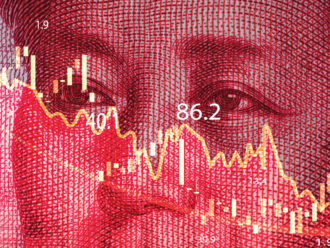Since the Great Recession, global real GDP growth is up 15%, according to Blackrock, but that remains at the lower end of the normal range of economic activity compared to the average recession in the last 50 years. Meanwhile, in the asset market, the NASDAQ and S&P 500 are 69% and 54% higher than they were at the pre-crisis peak in the S&P 500. High yield is up 75% and the monetary base has more than trebled.
“Globally we are very early in the interest rate cycle, mid-way through the economic cycle and at the end of the valuation cycle,” says David Vickers, managing director – multi-assets at Russell Investments. “We are here because of QE. We wouldn’t typically expect valuations to be where they are given where interest rates are. We have not had this historically.”
Since the 1980s, some innovations have also changed the markets fundamentally.
The first has been the considerable increase in the availability of leverage, which some argue makes the market a riskier place. Using futures, for example, an investor can get exposure worth many multiples of the cash required to cover a margin call. In the case of forward currency contracts, investors can take significantly leveraged positions without posting any cash.
Data from the Futures Industry Association Annual Volume Survey in 2014 showed the total volume of futures and options traded across 84 exchanges globally increased from 6000 in 2002 to a peak of 25,000 by 2011. Although total volume subsequently fell, it remained well over 20,000 in 2012 and began rising again in 2013. The numbers for 2014 were not available at the time of writing.
“Investors are able to take huge positions without spending any cash. If you lose money you can get into trouble,” Lustig says. “If lot of people are doing it, the market can quickly run into real trouble.” The growth of high-frequency trading, which became possible after the US Securities and Exchange Commission (SEC) authorised electronic trading in 1998, has also been blamed for exacerbating volatility in the markets.
“Volatility can be amplified,” Lustig says. “If asset prices start falling, more players will be jumping on the trade, which will create extremes.”
WHAT ABOUT VOLATILITY?
So is the world more volatile than it has been in the past?
“The question is whether the volatility environment is any different,” states Tim Edwards, director, index investment strategy at S&P Dow Jones Indices. “There are nuances to markets and things do change, but is that hugely different from what we have seen before?
“It isn’t particularly,” he continues. “We are not on untraveled ground. The world hasn’t really changed. The last 100 years have encompassed a range of very different situations. The most important thing is the myopia we all face. Markets have very short memories.”
Analysis of volatility indexes and the oldest of the equity indexes suggests volatility is much as it always has been, if not lower.
In 1993, the VXO volatility index was introduced, which offered a view of volatility on – the S&P 500 backtested to 1986, further back than the more commonly known VIX volatility index. The basis for the two are slightly different – while the VIX is based on option prices for the S&P 500, the VXO tracks options prices on the S&P100.
But it also shows something even more interesting. The spike in volatility as measured by the VXO that occurred during 1988 was far more extreme than that seen in the 2008 Financial Crisis. During 1987 the VXO spiked from below 20 to over 150, nearly twice the peak of the 2008 crisis, when the VXO spiked from a similar base to just over 80.




Comments